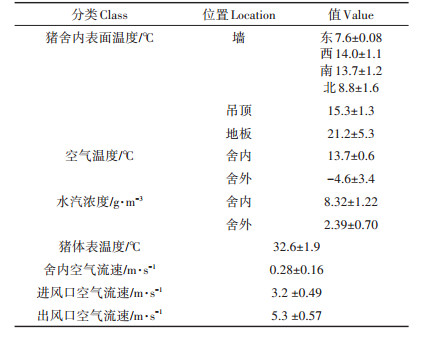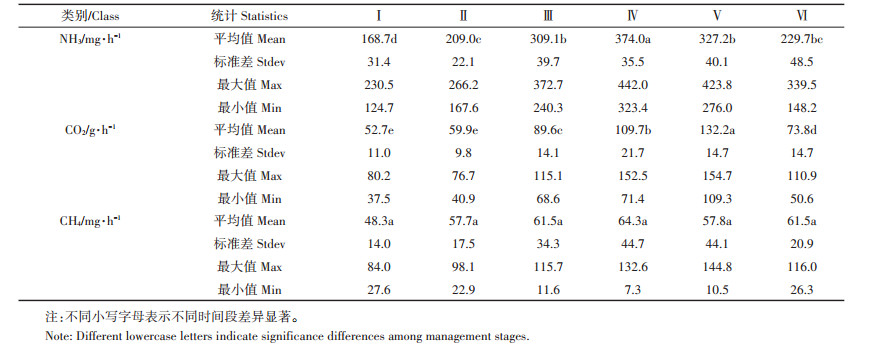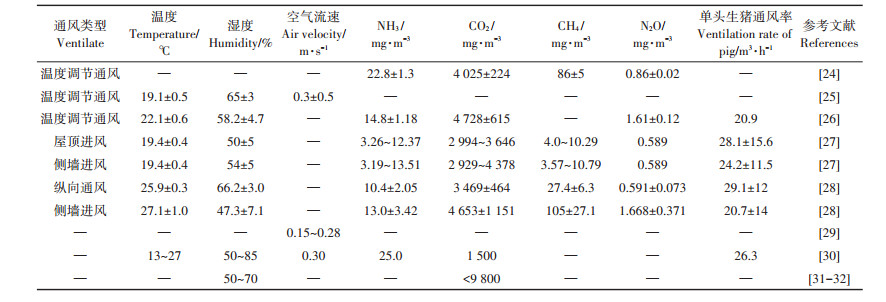2. 江苏省农业科学院农业设施与装备研究所, 农业农村部长江中下游设施农业工程重点实验室, 南京 210014
2. Institute of Facilities and Equipment in Agriculture, Jiangsu Academy of Agricultural Science, Key Laboratory for Protected Agricultural Engineering in the Middle and Lower Reaches of Yangtze River, Ministry of Agriculture and Rural Affairs, Nanjing 210014, China
生猪集约化养殖过程中,为了维持较高的生产效率,在较小的土地面积上投入了大量的饲料、水和能源等,这些资源的使用缩短了物质的循环周期,影响着环境与生物间的物质能量平衡[1-2],集约化生猪生产过程产生大量的粪便和污水,成为重要的污染源[3-5]。有研究表明,氮肥施用和畜禽养殖一直是最主要的氨排放源,共占氨排放总量的80%以上[6],粪便中大量的碳氮等物质,经过微生物代谢分解,成为NH3和温室气体(CH4、N2O和CO2)排放的主要来源。NH3的过量排放会影响整个农业生态系统的物质循环,加剧农田生态系统铵态氮沉降[7],引起水体富营养化和土壤环境酸化[8],同时NH3以硫酸铵和硝酸铵的形式进入大气中,形成可吸入性颗粒物PM2.5的前体[9],影响生猪和饲养员的健康,进一步导致N2O的排放[10],同时由于N2O与CH4和CO2共同通过改变气溶胶和云的物理特性,进一步增强对太阳辐射的散射作用,进而影响气候的变化[11]。
然而生猪养殖过程中氨气和温室气体的排放受到动物自身特征(动物活动、体质量和数量以及饲料营养水平) [12-13]、养殖工艺与模式[14-15]、舍内粪便管理模式[16-18]的影响。不同通风管理方式影响舍内的环境质量和污染物的排放,在冬季猪舍通风系统中,进气口尺寸、数量以及气流分布和速度是影响猪舍环境的主要因素,目前部分密闭式机械通风猪舍冬季仍然采用纵向通风管理,为保证猪舍内适宜的温湿度条件,风机运行间隔时间过长、排气流量过高导致舍内空气温度分布不均匀,对生猪生产造成影响。目前通过合理的通风管理(通风量和空气流速)改善猪舍内环境质量并降低猪舍氨气和温室气体的排放,成为控制养殖过程空气污染物排放的主要手段,本文据此制定适合该区域最佳的通风管理策略[19-20]。为确定冬季通风管理对猪舍内环境质量以及氨气和温室气体排放的影响,本研究对江苏苏北地区密闭式机械纵向负压通风水冲清粪猪舍的冬季通风系统进行了改造,由纵向负压通风改为侧窗负压通风方式。目前侧窗负压通风下猪舍内环境质量以及氨气和温室气体数据缺乏。本文探讨了6阶段通风管理模式对猪舍内环境状况以及氨气与温室气体排放的影响,阐述了不同通风时段密闭型猪舍氨气和温室气体浓度的变化特征及排放规律,研究结果为改善猪舍内空气环境质量、降低氨气和温室气体排放提供技术和数据支持。
1 材料与方法 1.1 生猪养殖设施及设备试验选择气候条件稳定的2016年1月23日至26日,在江苏省淮安市某规模化养猪场(33°30′ 57.81″ N,118°49′23.54″ E,海拔17 m)进行。试验猪舍为密闭式猪舍,猪舍尺寸为54.0 m×14.0 m×3.6 m(长×宽×高),外围护结构为砖混结构,屋顶由彩钢岩棉夹心板覆盖,以提高冬季保温和夏季隔热性能,猪舍中间砌有砖墙与猪舍吊顶将猪舍分成两个独立的养殖仓,其主要结构及尺寸见图 1。冬季通风方式选择侧墙通风小窗-风机负压通风,猪舍通风系统由4台直径为138 cm的风机(额定功率为1.1 kW,额定风量为32 000 m3·h-1)和2台直径为92 cm的风机(额定功率为0.37 kW,额定风量为27 000 m3·h-1)组成,工作静压10~60 Pa,进气系统由设置在猪舍侧墙1.8 m处的12个尺寸为55.0 cm×25.0 cm(长×宽)的通风小窗组成。试验猪舍生猪养殖量为500头,由水泥墙分割成两个独立的养殖仓,每个独立的养殖仓饲养250头,分为7栏饲养,喂食采用自由采食方式,每栏设有1个饮水器和1个饲料槽,采用自动喂料和饮水系统,猪舍采用水冲清粪方式,每日清粪1次;育肥周期4~5个月,试验期间生猪平均质量75 kg。

|
图 1 猪舍结构与通风系统 Figure 1 Pig house′s dimensions and ventilation systems |
选择北侧生猪养殖仓,在舍外和仓内15.0、30.0、45.0 m处,1.0 m高度分别安装1台HOBO温湿度记录仪(HoboPro Data logger,Onset Computer Corporation,USA)测定舍内温湿度,采集频率为5 min·次-1。每日分别在4:00—5:00、8:00—9:00、10:00—11:00、13:00— 14:00、16:00—17:00、19:00—20:00,使用Testo405- V1手持式热敏风速仪(Testo AG,Germany)测定猪舍内3个温湿度测试点空气的流速,使用数字风速计(TM826,TECMAN,China)测定通风每个小窗进气口和风机出气口的风速,使用非接触式红外测温仪(Fluke 572-2,Fluke,USA)测定猪舍内表面和猪体表温度。非接触式红外测温仪的发射率设定值分别为混凝土材料0.95,金属材料0.8,玻璃材料0.85,猪体0.90。舍内外氨气(NH3)、二氧化碳(CO2)、甲烷(CH4)和氧化亚氮(N2O)的浓度由INNOVA1412多功能气体分析仪(Innova Air Tech Instruments A/S,Denmark)连续测定,测定频率为5 min·次-1,舍内测试点位于排风口处,距离排风风机6~7 m,舍外气体浓度测试点同温湿度测试点。
1.3 通风量计算模型猪舍通风量的计算采用湿度平衡法计算:

|
(1) |
式中:VRh为猪舍的通风量,m3·h-1;A为动物活动参数;L为猪舍潜热生产量,W;Wi、Wo为舍内外空气的水汽浓度,kg·m-3;hvap为猪舍水汽蒸发热,J·kg-1。动物活动系数A参考Blanes等[21]推荐值,生猪舍潜热生产参考Pedersen等[22]和Schauberger等[23]计算方法,参数详见表 1。湿度平衡法计算猪舍的通风量在舍内外温差大于2 ℃,水汽浓度差值大于0.5 g·m-3时具有较高的准确性[22]。
|
|
表 1 生猪活动系数与潜热生产 Table 1 Animal activity coefficient and latent heat production |
猪舍水汽蒸发热与猪舍内温度有关,计算公式如下:

|
(2) |
式中:Ti为舍内空气温度,℃。
舍内外空气的水汽浓度计算见公式(3)与公式(4):

|
(3) |

|
(4) |
式中:Wi, o为舍内外空气的水汽浓度,kg·m-3;RHi, o为舍内外空气的相对湿度,%;Psat为饱和蒸汽压,Pa;Patm为标准大气压,Pa;Ti, o为舍内外空气的温度,℃。
1.4 气体排放率确定通过对猪舍NH3、CO2、CH4和N2O的浓度以及通风量的测定,生猪冬季气体排放因子的计算公式如下:

|
(5) |
式中:ERpig为单头生猪的气体排放率,mg·h-1;VRh为猪舍的通风量,m3·h-1;Ci、Co为舍内外气体浓度,mg· m-3;n为舍内生猪的数量,头;t为通风时间,h。
1.5 数据统计分析数据统计分析采用SAS 9.4软件和Excel工具进行,方差分析采用单因素方差分析(One-way ANOVA),Duncan新复极差法检验不同试验间的显著性差异,显著水平为P < 0.05。
2 结果与分析 2.1 舍内外气候条件猪舍内气候环境指标见表 2,猪舍内温度的日变化见图 2,结果显示舍外温度变化较大,最高温度出现在12:30,为1.3 ℃,最低温度出现在22:30,为-8.2 ℃;猪舍内的温度变化较为平稳,温度范围在11.5~14.7 ℃,平均为13.7 ℃。舍内外温差在11.0~21.7 ℃,平均舍内外温差为17.8 ℃,舍内温度均大于11.0 ℃,满足了育肥猪生长对温度的需求。舍内外相对湿度变化范围分别为44.9%~82.6%、41.6%~80.3%,平均相对湿度分别为69.7%、62.5%,平均湿度差值在0~22.4%变化,平均舍内外湿度差值为6.8%,水汽浓度差值为5.93 g·m-3。
|
|
表 2 猪舍内环境指标 Table 2 Environmental indicators in pig house |

|
图 2 舍内外温湿度的变化 Figure 2 Measured outdoor and indoor air temperature and relative humidity |
生猪养殖过程根据舍外气候条件将通风管理设置为6段通风管理模式,每个通风模式下的通风量使用数字风速计测定,不同通风模式的运行时间及通风管理见表 3,猪舍直接测定的通风率在3 100~11 520 m3·h-1变动,平均通风率为6 165 m3·h-1(单头生猪通风量24.7 m3·h-1);湿度平衡法测定的通风率在3 231~ 11 498 m3·h-1,平均通风率为6 207 m3·h-1(单头生猪通风量24.9 m3·h-1)。最大通风量和最小通风量的运行时间分别在11:00—14:00和00:00—5:00,直接测定通风量与湿度平衡法测定通风量的差值为42.0 m3·h-1,显示湿度平衡法在计算冬季密闭型猪舍的通风量时具有较高的准确性。
|
|
表 3 猪舍不同时间段通风量 Table 3 Ventilation rate for pig house in different stages |
侧窗通风密闭式猪舍生猪育肥过程中舍内CO2、NH3和CH4浓度变化见图 3,试验过程中没有监测到N2O的排放。猪舍内气体浓度日变化呈现先降低后升高的趋势,夜间由于通风量较小,气体浓度明显高于日间浓度。整个试验期间猪舍内CO2浓度由于通风管理的差异,存在显著的日变化,变化范围在2 509~5 303 mg·m-3之间,平均为4 330 mg·m-3,舍外CO2平均浓度为921 mg·m-3;冬季密闭通风式猪舍NH3浓度变化在8.42~15.63 mg · m-3,平均浓度为11.99 mg·m-3,舍外平均NH3浓度为1.10 mg·m-3。CH4浓度变化在1.11~5.90 mg·m-3,平均为3.91 mg·m-3,舍外平均CH4浓度为1.31 mg·m-3。
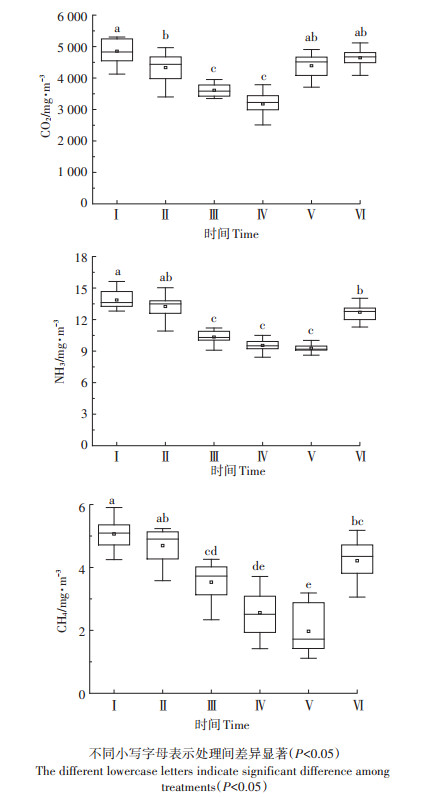
|
图 3 舍内CO2、NH3、CH4浓度变化 Figure 3 The concentration variation of CO2, NH3, and CH4 in pig house |
养殖过程不同通风管理阶段单头生猪NH3、CO2和CH4的排放率见表 4。结果显示试验期间单头生猪的NH3排放率变化范围在124.7~442.0 mg·h-1,平均为250.0 mg·h-1,一天中NH3排放率在第Ⅳ阶段平均最高,达到374.0 mg·h-1,虽然该阶段舍内NH3浓度较低,但是较高的通风量导致排放率显著高于其他5个通风管理阶段。NH3排放率在第Ⅰ阶段最低,平均值为168.7 mg · h-1,由于夜间外界温度较低(平均为-8.2 ℃),为维持适宜的舍内温度,该阶段采用较小的通风量管理。试验期间生猪的CO2排放率变化范围在37.5~154.7 g·h-1,平均为79.9 g·h-1,一天中CO2排放率在第Ⅴ阶段中平均最高,达到132.2 g·h-1,显著高于其他5个通风管理阶段。CO2排放率在第Ⅰ、Ⅱ阶段最低,分别为52.7 g·h-1和59.9 g·h-1。生猪CO2的排放受生猪体质量和活动水平的影响,其主要产生于生猪消化饲料为自身提供能量的过程,试验猪舍采用水冲清粪方式,冬季温度较低,粪便微生物代谢产生的CO2可以忽略不计。试验期间生猪的CH4排放率变化范围在7.3~144.8 mg·h-1,平均为57.7 mg·h-1,不同通风阶段CH4的排放率差异不显著。
|
|
表 4 不同通风管理阶段单头生猪NH3、CO2和CH4的排放率 Table 4 Emission rates of NH3, CO2, and CH4 from pig in different ventilation management stages |
冬季侧窗负压通风猪舍单头生猪NH3、CO2和CH4日累计排放量见图 4。生猪在不同通风阶段NH3、CO2和CH4日累计排放量由于通风时间和通风量的不同存在一定的差异。结果显示试验期间生猪的NH3日累计排放量为6.0 g·d-1,不同通风阶段NH3排放的比例分别为Ⅰ段14.1%、Ⅱ段15.7%、Ⅲ段10.3%、Ⅳ段18.7%、Ⅴ段16.4%、Ⅵ段24.9%;CO2总排放量为1.92 kg·d-1,不同通风阶段CO2排放的比例分别为Ⅰ段13.7%、Ⅱ段14.1%、Ⅲ段9.3%、Ⅳ段17.2%、Ⅴ段20.7%、Ⅵ段25.0%;CH4总排放量为1.39 g·d-1,不同通风阶段CH4排放的比例分别为Ⅰ段17.9%、Ⅱ段19.2%、Ⅲ段9.1%、Ⅳ段13.5%、Ⅴ段10.7%、Ⅵ段29.6%。
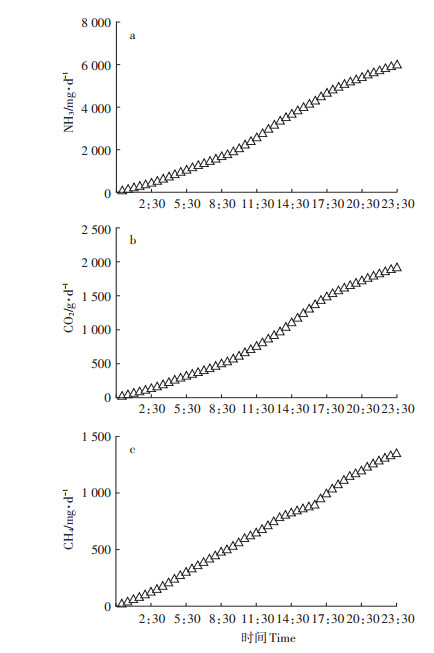
|
图 4 单头生猪NH3、CO2、CH4日累计排放 Figure 4 The concentration variation of CO2, NH3, and CH4 of single pig |
研究显示,在冬季猪舍通风系统中,进气口尺寸、数量以及气流分布和速度是影响猪舍环境的主要因素,改造之前的猪舍冬季采用纵向通风管理,为保证猪舍内适宜的温湿度条件,风机运行间隔时间过长、排气流量过高导致舍内空气温度分布不均匀,对生猪生产造成影响。室外温度的昼夜变化以及不同通风管理时段通风速率的变化影响舍内NH3和温室气体的浓度,文献中不同地区不同通风管理方式猪舍内环境指标见表 5。
|
|
表 5 不同通风管理猪舍内环境指标 Table 5 Environmental indicators of pig house with different ventilation managements |
此外,由于不同猪舍类型粪便管理模式不同,进一步影响了气体的排放,见表 6。在生猪养殖过程中NH3的排放主要是由粪便中的微生物通过脲酶降解尿素产生,NH3排放过程受到粪便表面空气速度、粪便表面积、空气温度、粪便pH值等参数的影响[41]。不同地区由于管理措施和猪舍结构不同,NH3的排放存在很大的差异,经常清除舍内粪便或者对粪污固液分离可以有效减少舍内NH3的排放。研究显示使用漏缝地板系统和刮板清粪的猪舍单头生猪NH3的排放在4.4~13.2 g·d-1(表 6),本研究水冲清粪猪舍试验期间单头生猪的NH3排放率为6.0 g·d-1,与这一结果非常接近。试验期间,与其他通风时段相比,Ⅲ、Ⅳ和Ⅴ阶段NH3的日排放量较高,主要与较高的通风率有关。研究发现较高的通风率会引起粪便表面的空气流速增加,导致较高的NH3排放[42]。
|
|
表 6 不同猪舍粪便管理方式污染物排放 Table 6 Pollutant emission of different pig houses for manure management |
猪舍中CO2排放来自于动物呼吸和粪便管理过程,猪舍内CO2的排放主要取决于动物的体质量、饲料水平和活动水平[34];舍内粪便管理过程CO2的排放来自于尿酶对动物尿液中尿素的水解和催化,以及粪便中有机成分的厌氧消化过程。其中粪便CO2的排放很大程度上受粪便管理方式的影响,通常漏缝地板系统和刮板清粪猪舍粪便管理过程CO2的排放占猪舍总排放的比例为2.3%~3.4%[43],而垫料养殖系统猪舍粪便管理过程CO2的排放占猪舍总排放的10%~ 20%,研究显示生猪育肥阶段体质量在23.3~113.5 kg的整个生长过程单头生猪CO2的排放在1.30~1.97 kg·d-1(表 6)。本研究中侧窗通风猪舍粪污清除采用水冲清粪方式,生猪体质量75 kg条件下CO2排放量为1.92 kg·d-1,与以上研究一致。猪舍的CO2排放量在第Ⅴ阶段最高,主要与这一阶段动物的活动有关。
CH4源自猪的肠道发酵和粪便中有机物的厌氧降解过程[44],这一过程与膳食纤维摄入水平有关[45]。在有机物质降解过程中,厌氧、pH中性、同时温度在25~40 ℃条件更有利于粪便CH4的产生[46]。研究显示使用漏缝地板系统和刮板清粪猪舍单头生猪CH4的排放在1.10~43.0 g·d-1(表 6),这主要与粪便及时清除有关;垫料生猪养殖系统CH4的排放高于漏缝地板和刮板清粪猪舍,这主要与垫料(稻草、锯木屑)可以提供可降解的碳水化合物来提高微生物的活性,从而增加CH4的排放有关[47]。本研究冬季侧窗通风CH4的排放量较小为1.39 g·d-1,主要与粪便及时清除和冬季猪舍通风量较小有关(单头生猪平均通风量24.9 m3·d-1)。猪舍的CH4排放量在第Ⅳ阶段最高,主要与这一阶段较高的通风量和动物的饲喂活动有关,但不同通风管理阶段的CH4排放差异不显著。
N2O是通过硝化-反硝化作用将NH4+转化为N2的过程中形成的,这一过程既需要有氧条件也需要无氧条件[48]。N2O的排放通常发生在厚垫料系统猪舍、粪便堆肥过程和粪便农田施用过程中,本研究没有监测到N2O的排放。
4 结论(1) 对改造后的冬季侧窗负压通风猪舍内平均温度、湿度、通风率和舍内平均空气流速等指标的测定结果显示,猪舍侧窗负压通风系统可满足冬季育肥猪生长的需求,NH3、CO2和CH4浓度等环境质量指标在可控范围内。
(2) 改造后的侧窗负压通风猪舍采用的6级通风管理模式显著影响NH3、CO2的平均排放率,在第Ⅳ、Ⅴ通风管理阶段NH3、CO2的平均排放率最高,第Ⅰ阶段NH3、CO2的平均排放率最低,对CH4的排放影响不显著。
| [1] |
Naylor R, Steinfeld H, Falcon W, et al. Losing the links between livestock and land[J]. Science, 2005, 310(5754): 1621-1622. DOI:10.1126/science.1117856 |
| [2] |
Steinfeld H, Wassenaar T. The role of livestock production in carbon and nitrogen cycles[J]. Annual Review of Environment and Resources, 2007, 32: 271-94. DOI:10.1146/annurev.energy.32.041806.143508 |
| [3] |
董红敏, 朱志平, 黄宏坤, 等. 畜禽养殖业产污系数和排污系数计算方法[J]. 农业工程学报, 2011, 27(1): 303-308. DONG Hong-min, ZHU Zhi-ping, HUANG Hong-kun, et al. Pollutant generation coefficient and discharge coefficient in animal production[J]. Transactions of the CSAE, 2011, 27(1): 303-308. DOI:10.3969/j.issn.1002-6819.2011.01.049 |
| [4] |
程龙, 郭秀锐, 程水源, 等. 京津冀农业源氨排放对PM2.5的影响[J]. 中国环境科学, 2018, 38(4): 1579-1588. CHENG Long, GUO Xiu-rui, CHENG Shui-yuan, et al. Effect of ammonia emission from agriculture in Beijing-Tianjin-Hebei on PM2.5[J]. China Environmental Science, 2018, 38(4): 1579-1588. |
| [5] |
阎波杰, 赵春江, 潘瑜春, 等. 规模化养殖畜禽粪便量估算及环境影响研究[J]. 中国环境科学, 2009, 29(7): 733-737. YAN Bo-jie, ZHAO Chun-jiang, PAN Yu-chun, et al. Estimation of the amount of livestock manure and its environmental influence of large-scaled culture based on spatial information[J]. China Environmental Science, 2009, 29(7): 733-737. DOI:10.3321/j.issn:1000-6923.2009.07.012 |
| [6] |
沈丽, 于兴娜, 项磊. 2006-2014年江苏省氨排放清单[J]. 中国环境科学, 2018, 38(1): 26-34. SHEN Li, YU Xing-na, XIANG Lei. Estimation of ammonia emissions inventories in Jiangsu Province from 2006 to 2014[J]. China Environmental Science, 2018, 38(1): 26-34. DOI:10.3969/j.issn.1000-6923.2018.01.003 |
| [7] |
Liu X J, Zhang Y, Han W X, et al. Enhanced nitrogen deposition over China[J]. Nature, 2013, 494: 459-462. DOI:10.1038/nature11917 |
| [8] |
Webb J, Sommer S G, Kupper T, et al. Emissions of ammonia, nitrous oxide and methane during the management of solid manures[J]. Agroecology and Strategies for Climate Change, 2012, 8: 67-107. |
| [9] |
Wu S, Hu J, Zhang Y, et al. Modeling atmospheric transport and fate of ammonia in North Carolina-Part Ⅱ:Effect of ammonia emissions on fine particulate matter formation[J]. Atmospheric Environment, 2008, 42(14): 3437-3451. DOI:10.1016/j.atmosenv.2007.04.022 |
| [10] |
IPCC. 2006 IPCC guidelines for national greenhouse gas inventories[R]. Hayama: Institute for Global Environmental Strategies, 2006.
|
| [11] |
Pinder R W, Davidson E A, Goodale C L, et al. Climate change impacts of US reactive nitrogen[J]. Proceedings of the National Academy of Sciences, 2012, 109(20): 7671-7675. DOI:10.1073/pnas.1114243109 |
| [12] |
朱志平, 董红敏, 尚斌, 等. 妊娠猪舍氨气及氧化亚氮浓度测定与排放通量的估算[J]. 农业工程学报, 2006, 22(14): 175-178. ZHU Zhi-ping, DONG Hong-min, SHANG Bin, et al. Measurement of ammonia and nitrous oxide concentrations and estimation of the emission rates from gestation pig buildings[J]. Transactions of the CSAE, 2006, 22(14): 175-178. |
| [13] |
Liu S, Ni J Q, Radcliffe J S, et al. Mitigation of ammonia emissions from pig production using reduced dietary crude protein with amino acid supplementation[J]. Bioresource Technology, 2017, 233: 200-208. DOI:10.1016/j.biortech.2017.02.082 |
| [14] |
康国虎, 董红敏, 陶秀萍, 等. 少污水排放垫料猪舍生产和环境效果[J]. 农业工程学报, 2009, 25(12): 259-264. KANG Guo-hu, DONG Hong-min, TAO Xiu-ping, et al. Evaluation on performance and thermal environment of hoop structure for finishing pigs[J]. Transactions of the CSAE, 2009, 25(12): 259-264. DOI:10.3969/j.issn.1002-6819.2009.12.046 |
| [15] |
Ngwabie N M, Chungong B N, Yengong F L. Characterisation of pig manure for methane emission modelling in Sub-Saharan Africa[J]. Biosystems Engineering, 2018, 170: 31-38. DOI:10.1016/j.biosystemseng.2018.03.009 |
| [16] |
朱宁, 秦富. 畜禽废弃物处理对规模养殖环境效率的影响[J]. 中国环境科学, 2015, 35(6): 1901-1910. ZHU Ning, QIN Fu. Influence of livestock and poultry's waste disposal on the environmental efficiency in scale breeding:From the perspective of layers' fecal disposal[J]. China Environmental Science, 2015, 35(6): 1901-1910. DOI:10.3969/j.issn.1000-6923.2015.06.037 |
| [17] |
Dennehy C, Lawlor P G, Jiang Y, et al. Greenhouse gas emissions from different pig manure management techniques:A critical analysis[J]. Frontiers of Environmental Science & Engineering in China, 2017, 11(3): 13-18. |
| [18] |
Petersen S O, Olsen A B, Elsgaard L, et al. Estimation of methane emissions from slurry pits below pig and cattle confinements[J]. PLoS One, 2016, 11(8): 1-16. |
| [19] |
Huffel K V, Hansen M J, Feilberg A, et al. Level and distribution of odorous compounds in pig exhaust air from combined room and pit ventilation[J]. Agriculture, Ecosystems & Environment, 2016, 218: 209-219. |
| [20] |
Cabaraux J F, Philippe F X, Laitat M, et al. Gaseous emissions from weaned pigs raised on different floor systems[J]. Agriculture, Ecosystems & Environment, 2009, 130(3/4): 86-92. |
| [21] |
Blanes V, Pedersen S. Ventilation flow in pig houses measured and calculated by carbon dioxide, moisture and heat balance equations[J]. Biosystems Engineering, 2005, 92(4): 483-493. DOI:10.1016/j.biosystemseng.2005.09.002 |
| [22] |
Pedersen S, Takai H, Johnsen J O, et al. A comparison of three balance methods for calculating ventilation rates in livestock buildings[J]. Journal of Agricultural Engineering Research, 1998, 70(10): 25-37. |
| [23] |
Schauberger G, Piringer M, Petz E. Steady-state balance model to calculate the indoor climate of livestock buildings, demonstrated for finishing pigs[J]. International Journal of Biometeorology, 2000, 43(4): 154-162. DOI:10.1007/s004840050002 |
| [24] |
Ulens T, Millet S, Ransbeeck N V, et al. The effect of different pen cleaning techniques and housing systems on indoor concentrations of particulate matter, ammonia and greenhouse gases(CO2, CH4, N2O)[J]. Livestock Science, 2014, 159: 123-132. DOI:10.1016/j.livsci.2013.10.024 |
| [25] |
Ocepek M, Škorjanc D. Does rearing system(conventional vs. organic)affect ammonia emissions during the growing and fattening periods of pigs[J]. Biosystems Engineering, 2016, 147: 81-89. DOI:10.1016/j.biosystemseng.2016.04.002 |
| [26] |
Rzeźnik W, Paulina M. Evaluation of the selected microclimate parameters in a fully-slatted piggery[J]. Research in Agricultural Engineering, 2015, 154(2): 75-87. |
| [27] |
Zong C, Li H, Zhang G. Ammonia and greenhouse gas emissions from fattening pig house with two types of partial pit ventilation systems[J]. Agriculture, Ecosystems & Environment, 2015, 208: 94-105. |
| [28] |
Ransbeeck N V, Langenhove H V, Demeyer P. Indoor concentrations and emissions factors of particulate matter, ammonia and greenhouse gases for pig fattening facilities[J]. Biosystems Engineering, 2013, 116(4): 518-528. DOI:10.1016/j.biosystemseng.2013.10.010 |
| [29] |
Verstegen M W A, Siegerink A, Van der Hel W, et al. Operant supplementary heating in groups of growing pigs in relation to air velocity[J]. Journal of Thermal Biology, 1987, 12(4): 257-261. DOI:10.1016/0306-4565(87)90025-8 |
| [30] |
中华人民共和国国家质量监督检验检疫总局, 中国国家标准化管理委员会.规模猪场环境参数及环境管理(GB/T 17824.3-2008)[S].北京: 中国标准出版社, 2008. General Administration of Quality Supervision, Inspection and Quarantine of the People's Republic of China, Standardization Administration of China. Environmental parameters and environmental management for intensive pig farms(GB/T 17824.3-2008)[S]. Beijing: China Standards Press, 2008. |
| [31] |
CIGR. Climatization of animal houses[R]. Belgium: Faculty of Agricultural Sciences, State University of Ghent, 1992.
|
| [32] |
CIGR. Report of working group on climatization of animal houses[EB/OL].(2002)[2019-12-18]. http://www.cigr.org/documents/CIGR_4TH_WORK_GR.pdf.
|
| [33] |
Philippe F X, Nicks B. Review on greenhouse gas emissions from pig houses:Production of carbon dioxide, methane and nitrous oxide by animals and manure[J]. Agriculture, Ecosystems & Environment, 2015, 199: 10-25. |
| [34] |
Ngwabie N, Jeppsson K H, Nimmermark S, et al. Effects of animal and climate parameters on gas emissions from a barn for fattening pigs[J]. Applied Engineering in Agriculture, 2011, 27(6): 1027-1037. DOI:10.13031/2013.40619 |
| [35] |
Ni J Q, Heber A J, Lim T T, et al. Methane and carbon dioxide emission from two pig finishing barns[J]. Journal of Environmental Quality, 2008, 37: 2001-2011. DOI:10.2134/jeq2007.0386 |
| [36] |
Hinz T, Linke S. A comprehensive experimental study of aerial pollutants in and emissions from livestock buildings. Part 2:Results[J]. Journal of Agricultural Engineering Research, 1998, 70: 119-129. DOI:10.1006/jaer.1998.0282 |
| [37] |
Liu Z, Powers W J, Liu H. Greenhouse gas emissions from swine operations:Evaluation of the Intergovernmental Panel on Climate Change approaches through meta-analysis[J]. Journal of Animal Science, 2013, 91(8): 4017-4032. DOI:10.2527/jas.2012-6147 |
| [38] |
Philippe F X, Laitat M, Nicks B, et al. Ammonia and greenhouse gas emissions during the fattening of pigs kept on two types of straw floor[J]. Agriculture, Ecosystems & Environment, 2012, 150: 45-53. |
| [39] |
Dourmad J Y, Hassouna M, Robin R, et al. Influence of pig rearing system on animal performance and manure composition[J]. Animal, 2009, 3(4): 606-616. DOI:10.1017/S1751731108003601 |
| [40] |
Nicks B, Laitat M, Farnir F, et al. Gaseous emissions from deep-litter pens with straw or sawdust for fattening pigs[J]. Animal Science, 2004, 78: 99-107. DOI:10.1017/S1357729800053881 |
| [41] |
Oliveira L V, Higarashi M M, Nicoloso R S, et al. Use of dicyandiamide to reduce nitrogen loss and nitrous oxide emission during mechanically turned co-composting of swine slurry with sawdust[J]. Waste and Biomass Valorization, 2019, 1-13. |
| [42] |
Ye Z, Zhang G, Seo I H, et al. Airflow characteristics at the surface of manure in a storage pit affected by ventilation rate, floor slat opening, and headspace height[J]. Biosystems Engineering, 2009, 104(1): 97-105. |
| [43] |
Zong C, Zhang G, Feng Y, et al. Carbon dioxide production from a fattening pig building with partial pit ventilation system[J]. Biosystems Engineering, 2014, 126: 56-68. DOI:10.1016/j.biosystemseng.2014.07.011 |
| [44] |
Dennehy C, Lawlor P G, Jiang Y, et al. Greenhouse gas emissions from different pig manure management techniques:A critical analysis[J]. Frontiers of Environmental Science & Engineering in China, 2017, 11(3): 1-16. |
| [45] |
Philippe F X, Remience V, Dourmad J Y, et al. Food fibers in gestating sows:Effects on nutrition, behaviour, performances and waste in the environment[J]. INRA Productions Animales, 2008, 21(3): 277-290. DOI:10.20870/productions-animales.2008.21.3.3402 |
| [46] |
Wang S, Ma F, Ma W, et al. Influence of temperature on biogas production efficiency and microbial community in a two-phase anaerobic digestion system[J]. Water, 2019, 11(1): 1-13. |
| [47] |
Sáez J A, Clemente R, Bustamante M Á, et al. Evaluation of the slurry management strategy and the integration of the composting technology in a pig farm-Agronomical and environmental implications[J]. Journal of Environmental Management, 2017, 192: 57-67. DOI:10.1016/j.jenvman.2017.01.040 |
| [48] |
Whalen J K, Thomas B W, Sharifi M. Novel practices and smart technologies to maximize the nitrogen fertilizer value of manure for crop production in cold humid temperate regions[J]. Advances in Agronomy, 2019, 153: 1-85. DOI:10.1016/bs.agron.2018.09.002 |
 2020, Vol. 39
2020, Vol. 39




